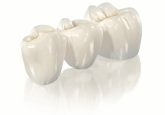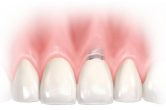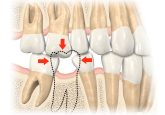
A single/several lost or damaged teeth can influence your daily life. Even though it may be at the back of your mouth and not visible from outside, over time it can start affecting your appearance, self-esteem, your oral health and even your health in general. When you lose a tooth, it disturbs the interplay between teeth and bone. Because gum and bone are no longer stimulated well enough due to the missing tooth & the jaw bone starts shrinking and your gum pulls back. This can weaken neighboring teeth until they collapse. Teeth in the opposite jaw can then start growing into the gap. The more teeth are missing, the more challenging it can become to replace them.
Missing teeth and a reduced jaw bone can make your face look older and wrinkly, and your cheeks become hollow and saggy, because they can no longer fully stabilize your lips and cheeks from the inside.
Dental crowns and bridges are also known as replacement teeth. They can be made of different material and are used to replace any tooth that is missing or beyond repair. A dental laboratory designs each replacement tooth individually, so that it matches the bite, look and feel of your other teeth.
A crown is used on a damaged tooth or on an implant.

A bridge can restore gaps between teeth. The outer parts of the bridge are placed on existing teeth next to the tooth gap, while the middle part replaces the lost tooth. Bridges can also be used on implants, usually when two or more teeth are missing.
To restore a missing tooth, your dentist can also use a bridge. It consists of several replacement teeth that will literally bridge the gap. But using bridges on natural teeth can have several serious disadvantages:

Certain types of bridges, made of metal covered with porcelain, can lead to visible black metal lines at the rim of the bridge when your gums keep receding. An all-ceramic bridge can provide an alternative in such cases. Speak to your dentist if an all-ceramic bridge might be a good solution for you.

Bridges are anchored to adjacent teeth to keep them in place. This means, that these neighboring teeth must first be reduced in size. To avoid grinding down teeth and effects on jaw bone and gum, your dentist can replace the tooth root to create a completely new tooth with a dental implant.
